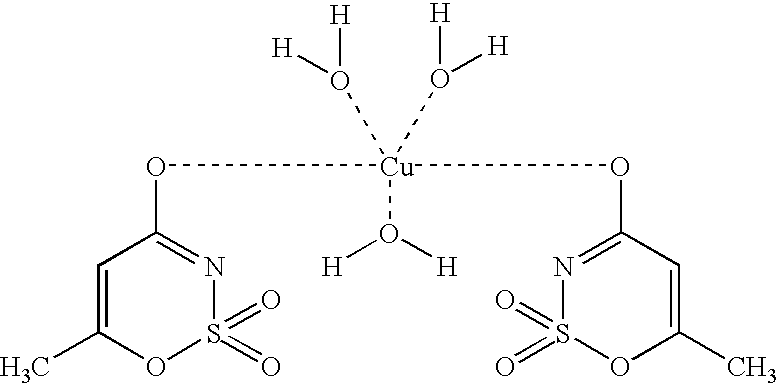Antimicrobially active acesulfame complexes, process for their preparation and their use
a technology of acesulfame and complexes, applied in the field of antibacterial activity of acesulfame complexes, process for their preparation and their use, can solve problems such as known separation problems, and achieve the effects of simple processing, good solubility and great antibacterial
- Summary
- Abstract
- Description
- Claims
- Application Information
AI Technical Summary
Benefits of technology
Problems solved by technology
Method used
Image
Examples
example 2
[0046] Acesulfame-Copper Complex:
[0047] Method 1:
[0048] 20 mmol (3.947 g) of slightly soluble barium carbonate (or 20 mmol of calcium carbonate) were introduced in 20 ml of water and 40 mmol (6.525 g) of acesulfame-H were added. After completion of CO.sub.2 formation a homogeneous solution resulted, from which slightly soluble barium sulfate (or calcium sulfate) was precipitated using 20 mmol (0.499 g) of copper(II) sulfate pentahydrate. After filtering off the precipitate and concentrating the solution, the acesulfame-copper complex crystallized out in the form of blue crystals at 96% yield.
[0049] Method 2:
[0050] 10 mmol (2.21 g) of slightly soluble basic copper carbonate (CuCO.sub.3Cu(OH).sub.2) were introduced in 20 ml of water and 40 mmol (6.526 g) of acesulfame-H were added. After completion of CO.sub.2 formation, a homogeneous blue solution resulted. After concentration of the solution, the acesulfame-copper complex crystallized out in the form of blue crystals at 98% yield.
[0...
example 3
[0054] Acesulfame-Silver Complex:
[0055] Method 1:
[0056] A solution of 30 mmol (5.148 g) of silver(I) nitrate in 30 ml of water was added to a solution of 30 mmol (6.037 g) of acesulfame-K in 30 ml of water. After addition was complete, the colorless precipitate formed was filtered off by suction and washed twice, each time with 10 ml of water. 88% of colorless acesulfame-silver crystals resulted. The reaction and subsequent workup as described above need not be carried out in the absence of light.
[0057] Method 2:
[0058] 15 mmol (3.48 g) of slightly soluble silver(I) oxide were introduced in 30 ml of water and a solution of 30 mmol (4.895 g) of acesulfame-H in 30 ml of water was added. After the reaction was complete, and workup as in method 1, 80% of colorless acesulfame-silver crystals resulted.
[0059] The crystal structure of the acesulfame-silver complex was established by X-ray structural analysis. 3
[0060] Crystal Data:
[0061] crystal system: monoclinic
[0062] space group: P2 / n; Z=8...
example 4
[0073] Acesulfame-Cetylpyridinium Complex:
[0074] Method 1:
[0075] 10 mmol (3.653 g) of cetylpyridinium chloride.H.sub.2O were dissolved in 25 ml of methanol and suspended with 10 mmol (2.012 g) of acesulfame-K. After stirring for 1.5 hours at room temperature, the precipitate formed was filtered off. The filtrate was concentrated in vacuo. The oily residue then crystallized out. This produced 90% of colorless nonhygroscopic crystals.
[0076] Method 2:
[0077] 10 mmol (3.653 g) of cetylpyridinium chloride.H.sub.2O were suspended in 75 ml of methylene chloride and 10 mmol (2.012 g) of acesulfame-K were added. After stirring for 1.5 hours at room temperature the precipitate formed was filtered off. The filtrate was concentrated in vacuo. The oily residue then crystallized out. This produced 95% of colorless nonhygroscopic crystals.
[0078] 60-MHz-.sup.1H-NMR (CDCl.sub.3): .delta.(ppm)=0.9 (t, 3H, CH.sub.3-cetylpyridine), 1.25 (m, 28H, CH.sub.2-cetylpyridine), 2.05 (s, 3H, CH.sub.3-acesulfame)...
PUM
| Property | Measurement | Unit |
|---|---|---|
| Solubility (mass) | aaaaa | aaaaa |
| Metallic bond | aaaaa | aaaaa |
| Miscibility | aaaaa | aaaaa |
Abstract
Description
Claims
Application Information
 Login to View More
Login to View More - R&D
- Intellectual Property
- Life Sciences
- Materials
- Tech Scout
- Unparalleled Data Quality
- Higher Quality Content
- 60% Fewer Hallucinations
Browse by: Latest US Patents, China's latest patents, Technical Efficacy Thesaurus, Application Domain, Technology Topic, Popular Technical Reports.
© 2025 PatSnap. All rights reserved.Legal|Privacy policy|Modern Slavery Act Transparency Statement|Sitemap|About US| Contact US: help@patsnap.com



